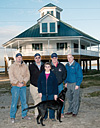
Daikin’s REFNET piping system helped ease the HVAC installation in the Townsends’ uniquely designed home.
PRINCESS ANNE, Md. - Homeowners Steve and Sandy Townsend wanted a new house with all the charm of a 142-year-old historic lighthouse, but with none of the worries about high energy bills. When the plans for the Hooper Strait Lighthouse became available, Townsend hired a Maryland architect to draw up blueprints for a lighthouse home with more modern conveniences. Once a design was agreed upon, finding a way to control the space’s temperature created a challenge. In stepped John Maguire.
A LIGHTHOUSE, A HOME?
Understanding the importance of retaining the integrity of the historic design eventually led Townsend and his design and construction team to choose a Daikin Variable Refrigerant Volume® system that has built-in intelligence enabling the homeowner to maintain precise zoning control over every square inch of his new home. Serving as general contractor on the job, Townsend brought in Maguire of All Seasons HVAC in Eden, Md., to recommend the right system for the unusual home.“There were a number of features of the Daikin system that made it perfect for Steve’s home,” said Maguire. “First, although it was a two-story home, Steve and his wife Sandy were going to primarily live on the first floor, so they wanted a system that could be easily zoned for their lifestyle. Second, living in an area with a lot of heat and moisture they needed a system that excelled at removing humidity from the living space. Third, they required a system that required minimal ductwork, which gave them much more flexibility in the design.”

Standing in front of the home of the Townsend family are (from left) John Webster of Parks & Webster Inc., John Maguire of All Seasons HVAC, Sandy Townsend, Steve Townsend, and Michael Panopoulos of Daikin AC.
NO WASTED ENERGY
Maguire recommended the Daikin VRV-S heat pump, with one 48,000 Btuh outdoor unit that connects to five wall-mounted FXAQ fan coil units and three slim-ducted, concealed FXDQ duct units. He explained that the VRV-S system is the Daikin model with a small capacity and would be more than adequate for the home.“The genius of an inverter system is that the home will only use the energy it needs at any one time. Since the Townsends are zoning the house, they may never use more than 24,000 Btuh at a time,” he said. “The way the system operates, it will only deliver enough refrigerant to feed whichever units are calling for it. So they will not be paying for the energy in unused rooms.”
According to the company, the Daikin compressor acts as a true variable-speed drive to the system, making it run continuously at the minimum speed that matches the capacity of the current load. By doing so, the compressor is typically operating at part load, which, according to the company, is ideal for high efficiency operation. Furthermore, by running the compressor continuously, the room experiences better dehumidification, which is perfect due to the location of the lighthouse.
The five wall-mounted units - measuring 31 by 11 by 9 inches - serve the living room, first-floor bedroom, two second-floor bedrooms, and the kitchen. The concealed ducted units serve the second-floor bathroom, the first-floor bathroom, and the foyer. All eight indoor units, connected to one outdoor unit, are individually controlled by a simplified wired controller. Each indoor unit incorporates an electronic expansion valve that continually controls the flow rate of refrigerant. In this way, the VRV system maintains a nearly constant room temperature without the typical fluctuations. The refined PID control delivers effective temperature control and minimizes temperature swings. With spray foam insulation incorporated into the structure’s energy efficient design and high-quality, double-paned windows facing out over the water, the Townsends’ energy cost is estimated to be very low.
Maguire and Townsend decided to take advantage of the fact that the shore home is built on pilings by installing the condenser on a specially designed structure below the home. They created a small deck for the slim 310 pound, 35 by 53 by 12 inches, outdoor unit and secured it with columns, placing it approximately 3 feet off of the ground.
“Although we sit on a flood plain here, the water level has never approached three feet in modern times,” noted Townsend.
To address the coastal application, the Daikin VRV-S outdoor unit coil includes anti corrosion coating and all the metal parts are enamel coated. These features give the outdoor unit longer life in salt-corrosion risk appli- cations. The overall design of the system was completed by Maguire and Daikin AC sales engineer Michael Panopoulos. Equipment was supplied by Andrew Mohr of Thos. Somerville Co., the local Daikin distributor.

Since the home is built on pilings, the Daikin VRV®-S heat pump was installed on a specially designed structure below the home.
A NEW HOME WITH HISTORY
The six-sided Townsend lighthouse home sits on Tangier Sound, which is the site where the first Hooper Strait Lighthouse was built and stood for less than a decade. Harsh winter weather and the pressure of mounting ice against the pilings caused the lighthouse to be separated from its base and drift out into the bay.Rebuilt a few years later, the lighthouse operated until it was decommissioned in 1966. The Chesapeake Bay Maritime Museum saved the structure from being demolished and relocated it to its on-air museum site. Today, lighthouse lovers from all around the world would definitely give it a top rating in its category.
“Since we plan to retire in our new lighthouse home, you could say we give it a top rating, too,” said Townsend.
Publication date:04/26/2010

Report Abusive Comment